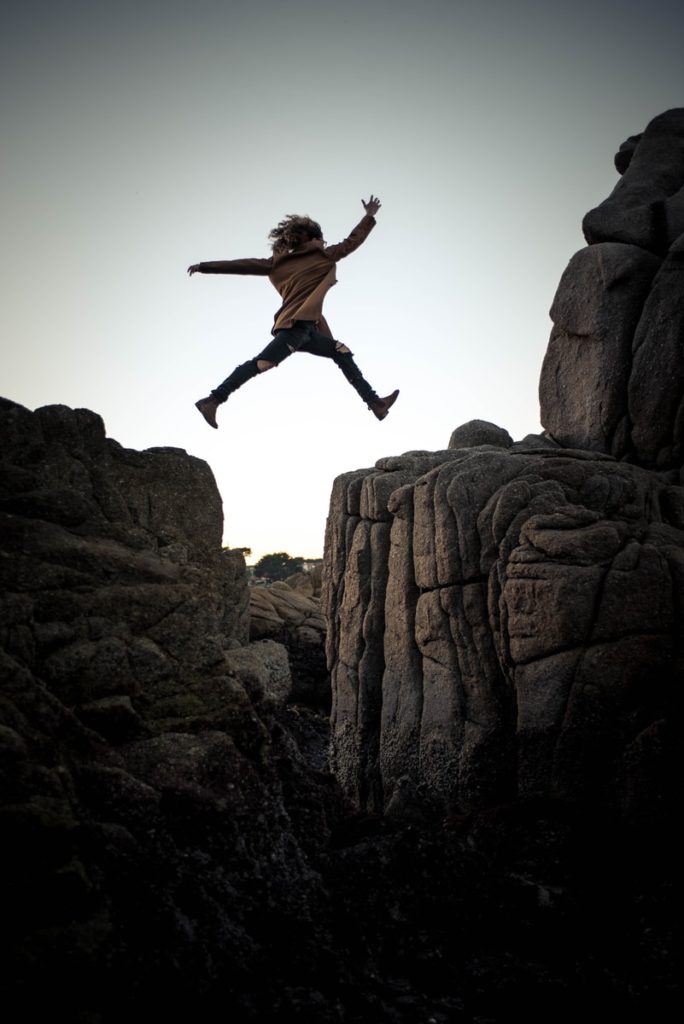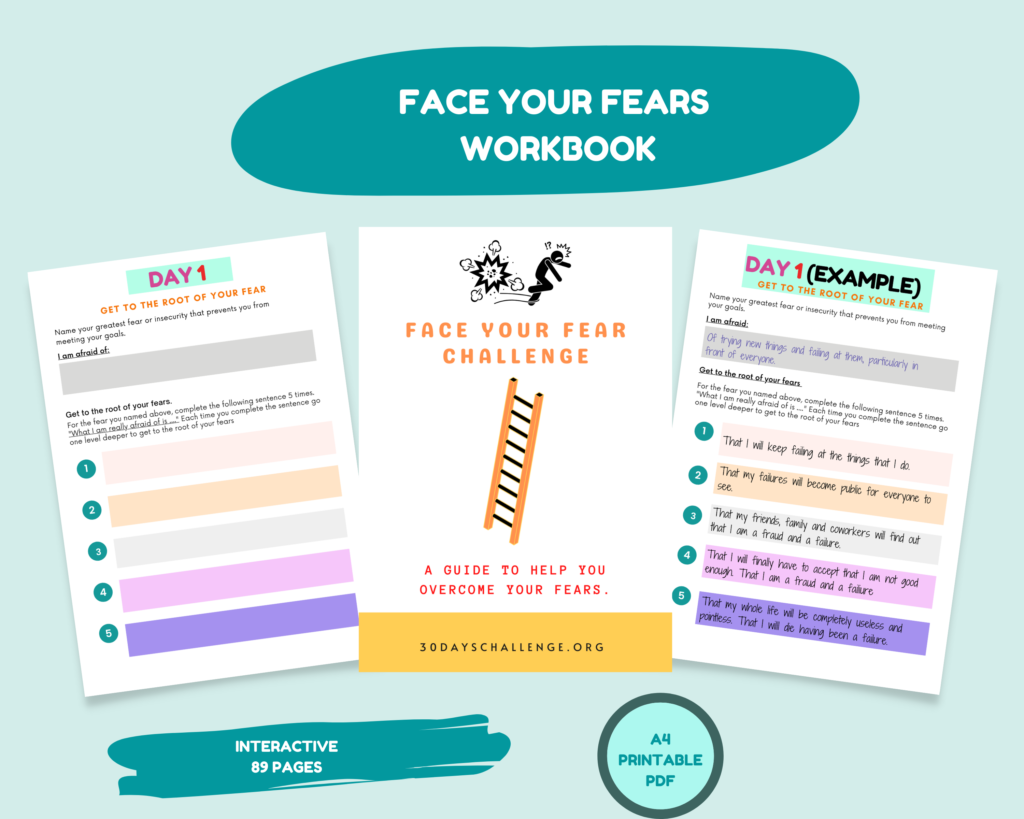Understanding Fear
Learning how to face your fears, first requires that you understand what fear really is.
Fear is an emotion that is typically associated with a feeling of danger or threat. It is one of the most basic and primal emotions that we experience, and it is designed to help us protect ourselves from harm.
When we see something we perceive as a threat, it triggers a response in our brain (the amygdala) which in turn floods our body with stress hormones so that we are able to effectively respond to the threat.
Join our 30 day face your fear challenge


How our brain determines what is a threat
Fear can be caused by a number of different things, including physical danger such as being attacked by a bear, and emotional danger such as the fear of being rejected by others.
Your brain decides whether or not something is a threat based on its past experiences, and the environment it is currently in. That’s why all of us experience events so differently.
If you have been bitten by a snake before and had a bad reaction your brain is more likely to be scared of a snake, and even mistake a stick for a snake. That’s because it is trying to protect you from being hurt again.
Similarly, if you have been hurt from an emotional event such as social rejection, your brain will always be on the lookout for situations that may hurt you again. And just the way your brain mistook the stick for a snake, it may also mistake perfectly innocent situations to be more threatening than they really are. Because it wants to ensure that you are NEVER hurt again.


This is why we feel afraid in harmless situations
Because our brain generalizes between situations, we often end up feeling threatened even when there is nothing to fear.
Have you ever walked into a social setting, and felt like everyone is judging you? It’s because your brain is remembering a past event where you were judged by others, and reminding you that there is the possibility of it happening again.
Teaching your brain to stop being afraid
The only way to stop being afraid of harmless situations is by showing your brain that you don’t need to be afraid of that situation anymore. This is called gradual exposure.
Gradual exposure is a process of teaching your brain that there is nothing to fear in a particular situation. It works by gradually exposing you to the situation that you are afraid of, in a safe and controlled way.
Each time you are exposed to the situation, and your worst fears aren’t realized, your brain realizes that the situation isn’t as scary or threatening as it originally thought it was.
This process can be used to help you overcome any fear, including the fear of public speaking, spiders, and social rejection.


How to face your fears through gradual exposure
The reality is the only real way to get rid of your fears is to face them head-on through gradual exposure. To do that you can follow the following steps.
Step 1: Write down your greatest fears
Begin by writing down your greatest fears. Ideally, these fears should be something that causes problems in your day-to-day life or something that prevent you from meeting your goals. Once you’ve written down everything that you are scared of, select one fear to focus on during your first gradual exposure attempt.
Here are some examples of fears that you could include on your list:
- Fear of public speaking
- Being afraid of rejection/embaressment
- The fear of failure
- Feeling afraid and insecure during social interactions
- Being afraid of driving
- The fear of speaking up for yourself
- Being scared that your reputation will be destroyed
Step 2: Create a fear ladder


A fear ladder is a list of activities that you are afraid of. At the bottom of the fear ladder should be activities that scare you slightly but are relatively easy to complete. At the top of the ladder, should be activities that are gradually scarier.
So for instance, if you are afraid of socializing, your fear ladder may look like this
- Strike up a conversation with the cashier at your grocery store.
- Sign up to a meetup group.
- Enroll in an event for the meetup group.
- Visualize having conversations with strangers, or at the playground.
- Make conversation with a stranger at the grocery store, or at the playground.
- Go to the meetup group event and speak to at least 1 person at the event.
- Go to another meetup group event and speak to at least 2 people at the event
What will be listed in your fear ladder will depend on the details of your fears. But the trick is to list activities that are least scary at the beginning of the fear ladder and then gradually allow yourself to face more scary fears.
When I completed a fear ladder for my public speaking here’s what it looked like
- Sign up for tiktok
- Post a 15 second tiktok video
- Speak up during live clubhouse events. (minimum 3)
- Take part in an impromptu speech.
- Do a 10 minute youtube video and get feedback from friends
- Post my 10 minute youtube video
- Do a live speech on clubhouse (only audio.)
- Do a live speech on facebook (Audio & Video)
It’s important to note, that I repeated some of these activities multiple times before I was ready to move on to the next step on my fear ladder. This was because I had to conquer each fear on my fear ladder before I was no longer afraid of it.
Step 3: Plan how to face your fears in detail


Once you’ve created your fear ladder, make sure to plan each activity in as much detail as you can. Try and be very specific about both your preparations and your goals for each activity.
Preparation: If you want to go to a meetup event, what exactly do you need to do to prepare? Do the preparation activities stress you out? Should they be included as different items on the fear ladder?
Goals: What is your goal for each fear ladder activity. Perhaps the first time you go to a social meetup, your goal is just to get through the meetup. The next time you go, you would like to make a point of at least talking to 2 people. Or add them on Facebook. Remember each incremental step on the fear ladder, should allow you to face your fears and insecurities just a bit more.
Step 4: Become comfortable with each fear before facing it


Facing your fears can be difficult, and anxiety-inducing. That’s why it’s important to first become comfortable with it before acing it head-on. That means that you understand why each activity on the list scares you so much.
Here are some questions you can ask yourself before you face each fear:
- What are you afraid will happen when you complete the activity?
- What is the worst that can happen?
- Do you think that the worst will actually happen, or is it unlikely. (Write down both arguments for, and against the possibility of it happening.)
- If your worst fears do materialize, will it really be the end of the world? If yes what are some things that you can do to deal with them?
Step 5: Face your fears


Once you have evaluated your fear more carefully, it is time to actually face your fear. It might be a good idea to do some breathing activities, journaling, or talking to a friend right before facing the fear. This will give you the courage and motivation you will need to actually face it head-on.
Step 6: Process your emotions after
Once you have faced your fear, you should spend some time calming your body and brain down, and processing how the fear activity made you feel.
It is perfectly normal to feel anxiety, and stress after completing the fear activity. That’s why it is so important to keep some time to both decompress and process your emotions.
Here are some journaling questions to process your emotions
- What exactly happened. Write down everything in detail
- How did you feel when you completed the activity?
- How do you feel now? Is there anyone you can talk to/anything you can do to make yourself feel better.
- Was your worst fear materialized? Was it as bad as you thought it would be?
- What did you do well when facing your fear? And what could you do better next time?
Make sure to take some time to be proud of yourself, or reward yourself for facing your fear. Because what you did was DIFFICULT. And you should be proud of yourself for what you did!
The benefits of facing your fears


You will feel more confident:
After facing your fears, you will realize that most of the things you were afraid of, were not actually that bad. You will realize that you are stronger and more capable than you realized. This will give you a boost in confidence, and make it easier for you to face future challenges in your life.
You will become braver:
Facing your fears makes you braver and more courageous. And as you become braver, it becomes easier and easier to face new challenges. Your brain gradually realizes that what it thought was a threat, was actually not that dangerous.
You will gain a better understanding of yourself:
As you face your fears head-on, you will learn more about what makes you anxious and stressed. You will also learn more about your capabilities, and how to deal with difficult emotions and situations.
Calming activities when you feel afraid


Journaling
Journaling is a great way to process your emotions. It can also be helpful in helping you face your fears. When you journal about your fears, it can help you to understand why they scare you, and what the worst-case scenario could be. This will help you to become more comfortable with your fears, and make it easier to face them head-on.
Talking to a friend/therapist
Talking to someone about your fears can also be helpful. It can help you to understand why they scare you, and how to deal with them. Sometimes it can be helpful to talk to someone who has already faced their fears. They can offer you advice and support on how to face your own.
Breathing exercises
Breathing exercises are a great way to calm yourself down when you are feeling anxious or stressed. They can help to slow down your heart rate and make you feel more relaxed.
Yoga and meditation are some great ways to calm your body down when you are feeling fear and anxiety.
Creative activities like painting, drawing, etc.
Creative activities can be a great way to deal with difficult emotions. They can help you to express what you are feeling, and can be a form of self-care. When you are feeling overwhelmed or stressed, take some time for yourself to do a creative activity that you enjoy. This will help to calm your mind and body down.
Listening to music can also be a great way to calm down and relax. It can help to soothe your mind and body and can be a great distraction from stressful thoughts or emotions. Choose music that makes you feel happy, peaceful, and relaxed.



